On December 7, 1941, the Japanese conducted a surprise attack on Pearl Harbor and sunk several warships that were moored pierside. You might think that incident caused the US Navy to build structures to protect ships in port, especially since most ships now cost over one billion dollars each. Take a look at this 1998 photo of the Pearl Harbor base.
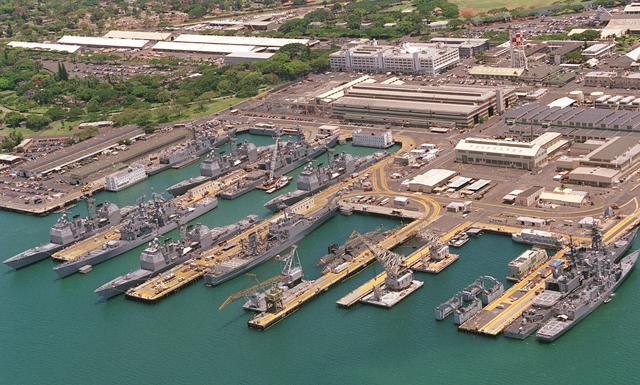
All the ships are tied up close together and in the open. Anyone in Hawaii can drive by and see what ships are in port and where they are located. Commandos from submarines, fishing boats, yachts, or private aircraft can pick out and attack targets easily. Of course enemy bombers can never attack Hawaii, which is what the Navy thought in 1941. Even a couple of guys with automatic rifles can cause millions of dollars in damage to modern ships from 1000 meters away. This same vulnerability exists at most US naval stations today, and is a great weakness in the US Navy.
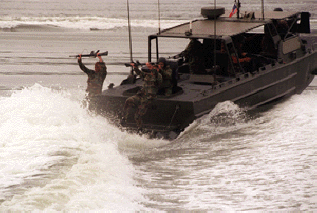 The Navy's top priority should be the construction
of large hangars to cover
piers. This will hide them from satellites and direct human
observation. Attackers would know that ships are inside some hangars, but they would not be sure which to target or exactly where to fire. If enemy bombers
or commandos launch missiles, they will explode when they
strike the hangar, causing little damage to the ships inside. Finally, if the area
is
hit by an Inter-Continental Ballistic Missile (ICBM), the hangars will absorb
some of the blast. Another advantage in keeping ships indoors is reduced weather damage to equipment and a much better maintenance work environment. Loading supplies and
making repairs will be safer and faster during bad weather days. The
British Navy has such hangars
at its base in Portsmouth.
The Navy's top priority should be the construction
of large hangars to cover
piers. This will hide them from satellites and direct human
observation. Attackers would know that ships are inside some hangars, but they would not be sure which to target or exactly where to fire. If enemy bombers
or commandos launch missiles, they will explode when they
strike the hangar, causing little damage to the ships inside. Finally, if the area
is
hit by an Inter-Continental Ballistic Missile (ICBM), the hangars will absorb
some of the blast. Another advantage in keeping ships indoors is reduced weather damage to equipment and a much better maintenance work environment. Loading supplies and
making repairs will be safer and faster during bad weather days. The
British Navy has such hangars
at its base in Portsmouth.
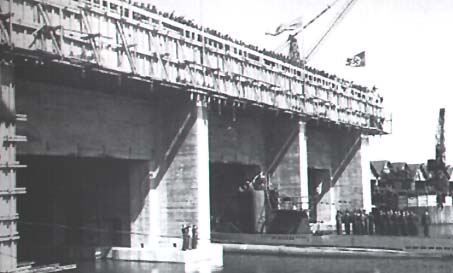 The US Navy must also get serious about
security and demand the US Marine Corps fulfill its mission of
defending Navy bases. A well armed boat, such as the Marine Corps' Riverine Assault
Craft (above), should patrol major Navy ports 24 hours a day and turn back any
small boats that approach Navy ships. In addition,
an armed Cobra attack helicopter with Stinger air-to-air missiles should be on
"Alert 5" 24 hours a day near each port, meaning it must be airborne
within five minutes of a request. The Cobra can also assist base law
enforcement in car chases and the Coast Guard. Finally, Marines with
rifles should control access to Navy piers.
The US Navy must also get serious about
security and demand the US Marine Corps fulfill its mission of
defending Navy bases. A well armed boat, such as the Marine Corps' Riverine Assault
Craft (above), should patrol major Navy ports 24 hours a day and turn back any
small boats that approach Navy ships. In addition,
an armed Cobra attack helicopter with Stinger air-to-air missiles should be on
"Alert 5" 24 hours a day near each port, meaning it must be airborne
within five minutes of a request. The Cobra can also assist base law
enforcement in car chases and the Coast Guard. Finally, Marines with
rifles should control access to Navy piers.
The Navy must develop a long-term plan to build "ship pens" similar to German U-boat pens from World War II. (above) These pens should be part of new bases far from large cities where security is impossible. Huge concrete bunkers covered by earth can protect ships from everything but direct nuclear hits. Countries like Norway have tunnels bored into rocky cliffs to hide small attack boats. It may be impractical to put huge aircraft carriers in pens, but submarines, cruisers and destroyers should be grouped in underground facilities, complete with a camouflaged entrance gate.
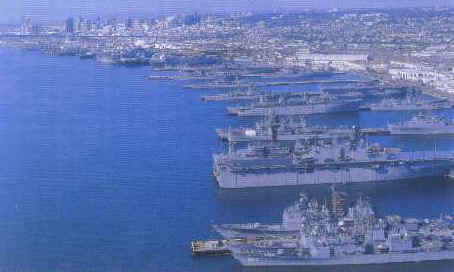 In past wars, many powerful ships have been sunk while tied up at naval
bases. In future wars, they will prove far more vulnerable because
worldwide communications allow agents to report shipping activity within
seconds. Navy ships in the port of San Diego (left) are extremely
vulnerable as they are located in a small bay and crowded urban area where
dozens of unmonitored pleasure craft cruise about that could be used to attack
billion-dollar warships. The three aircraft carrier berths are wide open to attack or ramming from any ship or
boat entering the harbor. All navies need ship pens to protect their expensive ships. Precision
guided munitions have made ships very vulnerable, especially tied up pierside.
In past wars, many powerful ships have been sunk while tied up at naval
bases. In future wars, they will prove far more vulnerable because
worldwide communications allow agents to report shipping activity within
seconds. Navy ships in the port of San Diego (left) are extremely
vulnerable as they are located in a small bay and crowded urban area where
dozens of unmonitored pleasure craft cruise about that could be used to attack
billion-dollar warships. The three aircraft carrier berths are wide open to attack or ramming from any ship or
boat entering the harbor. All navies need ship pens to protect their expensive ships. Precision
guided munitions have made ships very vulnerable, especially tied up pierside.
The US Navy may feel invincible at sea, but most ships are sitting ducks in crowded urban areas where security is a joke. While ships at sea are difficult to find, on a typical day more than half of US Navy ships are tied to piers marked on tourist maps with no protection from the air or sea. Some ships are even irresponsibly homeported in places like Sasebo, Japan where they are in easy range of Chinese or Korean aircraft and missile strikes. While no one expects funding or political support for moving ships to secure ports, the Navy can develop a 50-year plan to gradually move its homeports to safer areas. The World War II slogan "Remember Pearl Harbor" has been forgotten; its past time to address this issue before another sitting duck shoot occurs.
Sub Pens
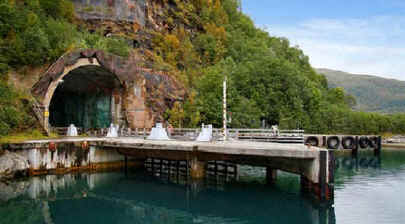 All submarine bases should be underground. It's ridiculous to spend over $2 billion
on a modern attack sub and then leave it tied up at an open pier. Pens were
built at a few places during the Cold War, like the one pictured in Norway,
which its government is recently sold for a measly $17 million. The US Navy should buy that one
for future use and build more. Make the entrance invisible by moving it below sea level so that subs would
surface inside the bunker, just like a beaver lodge. This makes non-nuclear
attacks impossible, and an enemy never knows if four subs are inside or none.
All submarine bases should be underground. It's ridiculous to spend over $2 billion
on a modern attack sub and then leave it tied up at an open pier. Pens were
built at a few places during the Cold War, like the one pictured in Norway,
which its government is recently sold for a measly $17 million. The US Navy should buy that one
for future use and build more. Make the entrance invisible by moving it below sea level so that subs would
surface inside the bunker, just like a beaver lodge. This makes non-nuclear
attacks impossible, and an enemy never knows if four subs are inside or none.
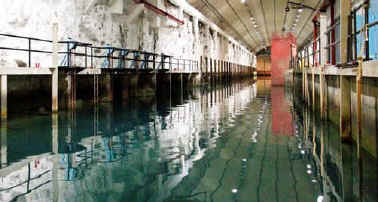 The
US Navy
should build a dozen of these at its naval bases around the world. An added
bonus is that subs can rearm and replenish in secret, no matter the weather.
Security costs far less because only the entrance need be guarded, and the
facility can be locked like a safe at the first sign of trouble. The only option
for an enemy is to try to disrupt the base by bombing the steel doors at the
truck entrance to the tunnel leading to the subs. But that debris can be quickly
cleared.
The
US Navy
should build a dozen of these at its naval bases around the world. An added
bonus is that subs can rearm and replenish in secret, no matter the weather.
Security costs far less because only the entrance need be guarded, and the
facility can be locked like a safe at the first sign of trouble. The only option
for an enemy is to try to disrupt the base by bombing the steel doors at the
truck entrance to the tunnel leading to the subs. But that debris can be quickly
cleared.
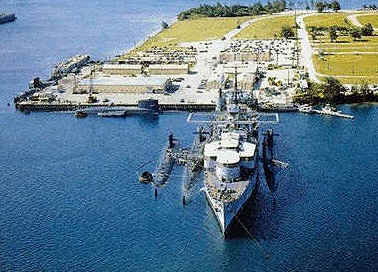 Compare this
concept to the US Navy's current bases. The photo at left is the US Navy submarine
base on Guam, within range of Chinese missiles and bombers. Since most of the
crew is ashore, it would take hours to get these subs underway and undersea
should war suddenly erupt. Chinese tourists/agents can rent boats or small
aircraft and take pictures, or potshots. It would not be difficult to conduct a
commando attack and knock out several subs. A small fire or small hole can cause
enough damage to ruin a modern high-tech sub. The attack sub USS Maine
recently suffered major fire damage caused a small trash fire and was scrapped!
Compare this
concept to the US Navy's current bases. The photo at left is the US Navy submarine
base on Guam, within range of Chinese missiles and bombers. Since most of the
crew is ashore, it would take hours to get these subs underway and undersea
should war suddenly erupt. Chinese tourists/agents can rent boats or small
aircraft and take pictures, or potshots. It would not be difficult to conduct a
commando attack and knock out several subs. A small fire or small hole can cause
enough damage to ruin a modern high-tech sub. The attack sub USS Maine
recently suffered major fire damage caused a small trash fire and was scrapped!
The ship in the picture is a "sub tender," which provides logistics support to deployed subs. That's an outdated concept since an enemy can simply track a sub tender and wait for a $2 billion sub to surface and tie up alongside, then sink both. Building an underground sub base on Guam and several other locations in the Pacific is the solution. That is much better than building new sub tenders and spending $5.5 billion on family housing and other buildings to move 5000 Marines and their families from Okinawa to Guam.
©2015 www.G2mil.com